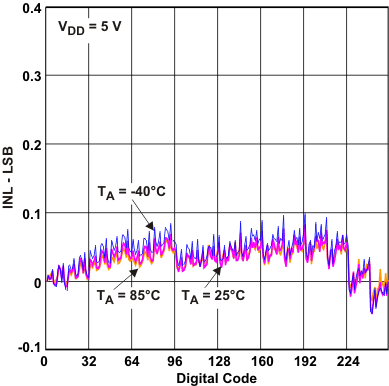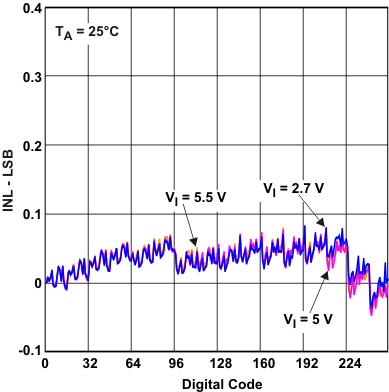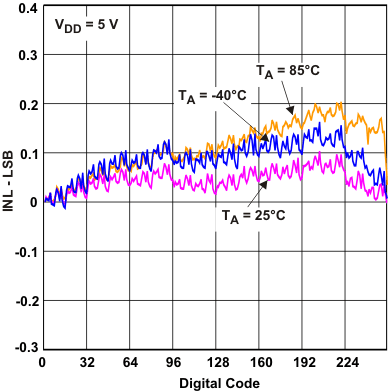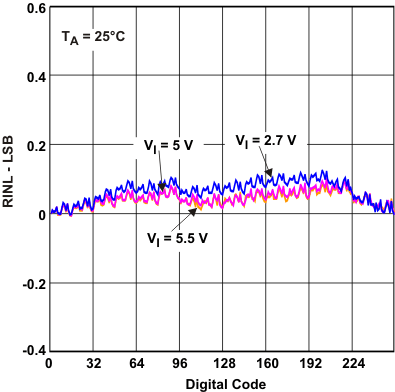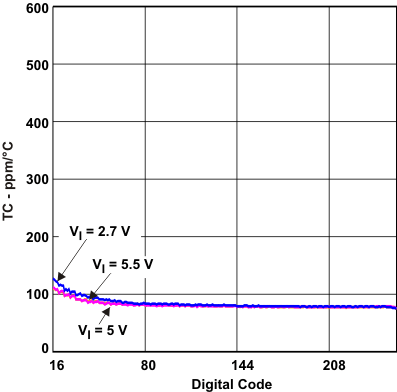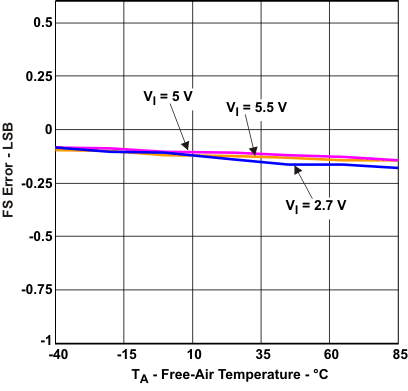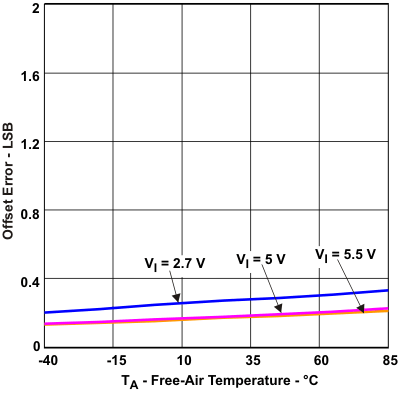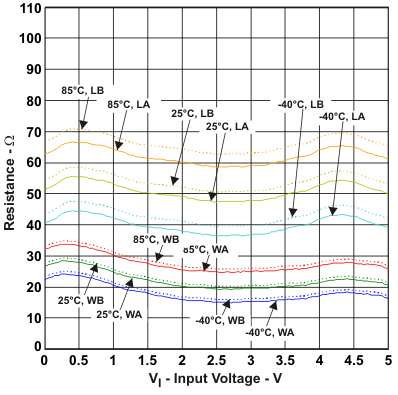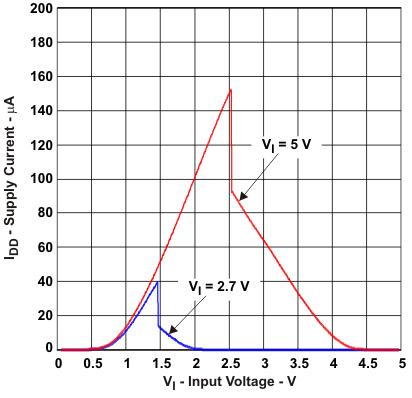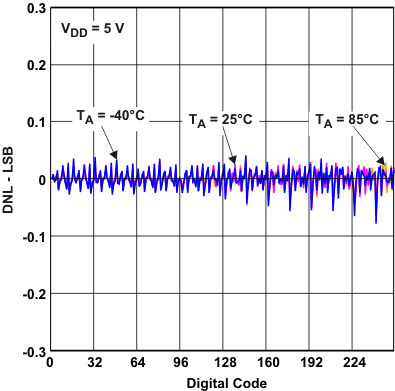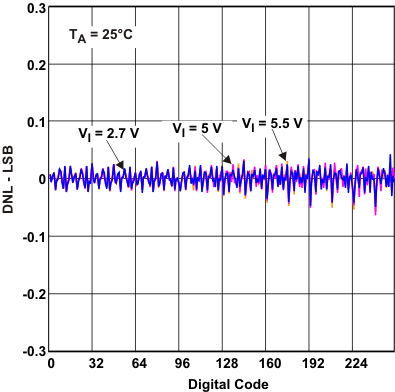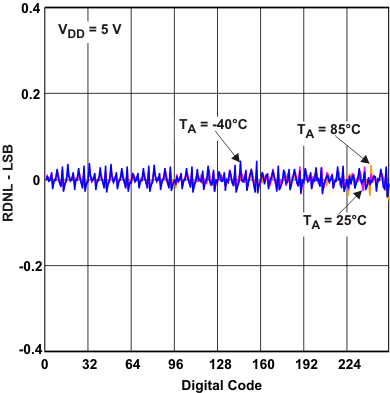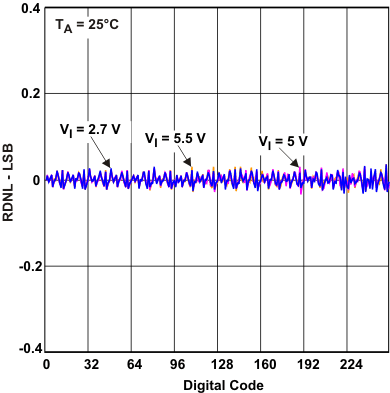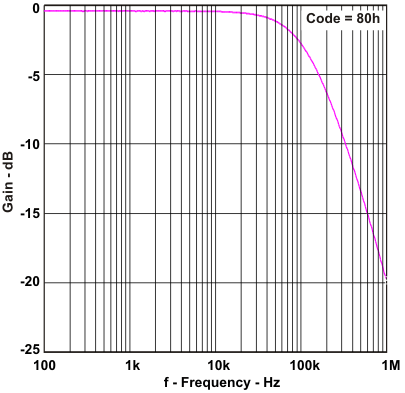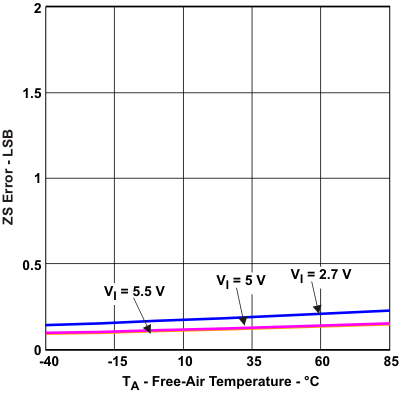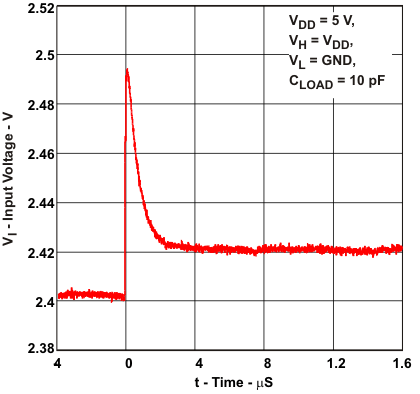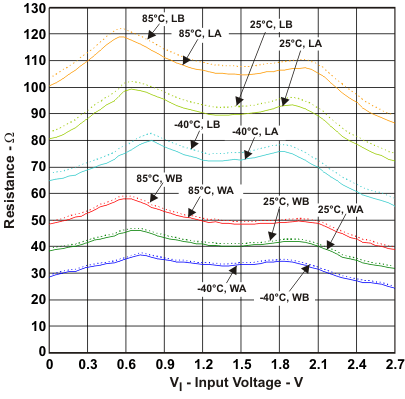SLIS134C March 2011 – September 2015
PRODUCTION DATA.
- 1 Features
- 2 Applications
- 3 Description
- 4 Revision History
- 5 Pin Configuration and Functions
- 6 Specifications
-
7 Detailed Description
- 7.1 Overview
- 7.2 Functional Block Diagram
- 7.3 Feature Description
- 7.4 Device Functional Modes
- 7.5 Programming with I2C
- 7.6
Register Maps
- 7.6.1 Slave Address
- 7.6.2 TPL0102 Register Map
- 7.6.3 IVRA (Initial Value Register for Potentiometer A)
- 7.6.4 WRA (Wiper Resistance Register for Potentiometer A)
- 7.6.5 IVRB (Initial Value Register for Potentiometer B)
- 7.6.6 WRB (Wiper Resistance Register for Potentiometer B)
- 7.6.7 ACR (Access Control Register)
- 8 Application and Implementation
- 9 Power Supply Recommendations
- 10Layout
- 11Device and Documentation Support
- 12Mechanical, Packaging, and Orderable Information
Package Options
Mechanical Data (Package|Pins)
Thermal pad, mechanical data (Package|Pins)
- PW|14
Orderable Information
6 Specifications
6.1 Absolute Maximum Ratings(1)(2)(3)
| MIN | MAX | UNIT | |||
|---|---|---|---|---|---|
| VDD to GND | Supply voltage | –0.3 | 7 | V | |
| VSS to GND | –7 | 0.3 | V | ||
| VDD to VSS | 7 | V | |||
| VH, VL, VW | Voltage at resistor terminals | VSS – 0.3 | VDD + 0.3 | V | |
| VI | Digital input voltage | –0.3 | VDD + 0.3 | V | |
| IH, IL, IW
|
Pulse current | ±20 | mA | ||
| Continuous current | ±2 | mA | |||
| Tstg | Storage temperature | -65 | 150 | °C | |
(1) Stresses above these ratings may cause permanent damage. Exposure to absolute maximum conditions for extended periods may degrade device reliability. These are stress ratings only, and functional operation of the device at these or any other conditions beyond those specified is not implied.
(2) The algebraic convention, whereby the most negative value is a minimum and the most positive value is a maximum.
(3) All voltages are with respect to ground, unless otherwise specified.
6.2 ESD Ratings
| VALUE | UNIT | |||
|---|---|---|---|---|
| V(ESD) | Electrostatic discharge | Human-body model (HBM), per ANSI/ESDA/JEDEC JS-001(1) | ±2000 | V |
| Charged-device model (CDM), per JEDEC specification JESD22-C101(2) | ±1000 | |||
(1) JEDEC document JEP155 states that 500-V HBM allows safe manufacturing with a standard ESD control process. Manufacturing with less than 500-V HBM is possible with the necessary precautions.
(2) JEDEC document JEP157 states that 250-V CDM allows safe manufacturing with a standard ESD control process. Manufacturing with less than 250-V CDM is possible with the necessary precautions.
6.3 Recommended Operating Conditions
over operating free-air temperature range (unless otherwise noted)6.4 Thermal Information
| THERMAL METRIC (1) | TPL0102 | UNIT | ||
|---|---|---|---|---|
| PW (TSSOP) | RUC (X2QFN) | |||
| 14 PINS | 14 PINS | |||
| RθJA | Junction-to-ambient thermal resistance | 112.9 | 119.4 | °C/W |
| RθJC(top) | Junction-to-case (top) thermal resistance | 39.9 | 51.3 | °C/W |
| RθJB | Junction-to-board thermal resistance | 55.9 | 59.0 | °C/W |
| ψJT | Junction-to-top characterization parameter | 3.5 | 1.2 | °C/W |
| ψJB | Junction-to-board characterization parameter | 55.2 | 59.0 | °C/W |
(1) For more information about traditional and new thermal metrics, see the IC Package Thermal Metrics application report, SPRA953.
6.5 Electrical Characteristics
VDD = 2.7 V to 5.5 V, VSS = 0 V, VH = VDD, VL = GND, TA = –40°C to 85°C (unless otherwise noted). Typical values are atVDD = 5 V, TA = 25°C (unless otherwise noted).
| PARAMETER | TEST CONDITIONS | MIN | TYP | MAX | UNIT | |||
|---|---|---|---|---|---|---|---|---|
| RTOT | End-to-End resistance (Between H and L Terminals) |
80 | 100 | 120 | kΩ | |||
| RH, RL | Terminal resistance | 60 | 200 | Ω | ||||
| RW | Wiper resistance | 25 | 100 | Ω | ||||
| CH, CL (14) (15) | Terminal capacitance | 22 | pF | |||||
| CW (14) (15) | Wiper capacitance | 16 | pF | |||||
| ILKG | Terminal leakage current | VH = VSS to VDD, VL = Floating OR VL = VSS to VDD, VH = Floating |
0.1 | 1 | µA | |||
| TCR | Resistance temperature coefficient | Input Code = 0x80h | 92 | ppm/°C | ||||
| RTOT,MATCH | Channel-to-channel resistance match | 0.1 | % | |||||
| Voltage Divider Mode | ||||||||
| INL(1)(3) | Integral non-linearity | –0.5 | 0.5 | LSB | ||||
| DNL(1)(4) | Differential non-linearity | –0.25 | 0.25 | LSB | ||||
| ZSERROR(2)(5) | Zero-scale error | 0 | 0.1 | 2 | LSB | |||
| FSERROR(2)(6) | Full-scale error | –2 | –0.1 | 0 | LSB | |||
| MATCHVDM(2)(7) | Channel-to-Channel matching | Wiper at the same tap position, same voltage at all H and same voltage at all L terminals | –2 | 2 | LSB | |||
| TCVDM | Ratiometric temperature coefficient | Wiper set at mid-scale | 4 | ppm/°C | ||||
| BW | Bandwidth | Wiper set at mid-scale CLOAD = 10 pF |
229 | kHz | ||||
| tSW | Wiper setting time | 3.6 | µs | |||||
| THD | Total harmonic distortion | VH = 1 VRMS at 1 kHz, VL = (VDD – VSS)/2, Measurement at pin W |
0.03 | % | ||||
| XTALK | Cross talk | fH = 1 kHz, VL = GND, Measurement at pin W |
–82 | dB | ||||
| RHEOSTAT MODE (Measurements between W and L with H not connected, or between W and H with L not connected) | ||||||||
| RINL(8)(10) | Integral non-linearity | –1 | 1 | LSB | ||||
| RDNL(8)(11) | Differential non-linearity | –0.5 | 0.5 | LSB | ||||
| OFFSETRM(9)(12) | Offset | 0 | 0.2 | 2 | LSB | |||
| MATCHRM(9)(13) | Channel-to-Channel matching | –2 | 2 | LSB | ||||
| BW | Bandwidth | Code = 0x00h, L Floating, Input applied to W, Measure at H, CLOAD = 10 pF |
54 | kHz | ||||
(1) LSB = (VMEAS[code 255] – VMEAS[code 0]) / 255
(2) IDEAL_LSB = (VH-VL) / 256
(3) INL = ((VMEAS[code x] – VMEAS[code 0]) / LSB) - [code x]
(4) DNL = ((VMEAS[code x] – VMEAS[code x-1]) / LSB) – 1
(5) ZSERROR = VMEAS[code 0] / IDEAL_LSB
(6) FSERROR = [(VMEAS[code 255] – (VH-VL)) / IDEAL_LSB] + 1
(7) MATCHVDM = (VMEAS_A[code x] – VMEAS_B[code x]) / IDEAL_LSB
(8) RLSB = (RMEAS[code 255] – RMEAS[code 0]) / 255
(9) IDEAL_RLSB = RTOT / 256
(10) RINL =( (RMEAS[code x] – RMEAS[code 0]) / RLSB) - [code x]
(11) RDNL =( (RMEAS[code x] – RMEAS[code x-1]) / RLSB )– 1
(12) OFFSETRM = RMEAS[code 0] / IDEAL_RLSB
(13) MATCHRM = (RMEAS_A[code x] – RMEAS_B[code x]) / IDEAL_RLSB
(14) Terminal and Wiper Capacitance extracted from self admittance of three port network measurement


(15) Digital Potentiometer Macromodel
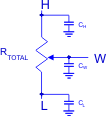

6.6 Operating Characteristics
VDD = 2.7 V to 5.5 V, VSS = 0 V, VH = VDD, VL = GND, TA = –40°C to 85°C (unless otherwise noted). Typical values are atVDD = 5 V, TA = 25°C (unless otherwise noted).
| PARAMETER | TEST CONDITIONS | MIN | TYP | MAX | UNIT | |
|---|---|---|---|---|---|---|
| IDD(STBY) | VDD standby current | VDD = 2.75 V, VSS = –2.75, I2C interface in standby mode |
0.2 | 1 | µA | |
| ISS(STBY) | VSS standby current | VDD = 2.75 V, VSS = –2.75, I2C interface in standby mode |
–1 | –0.2 | µA | |
| IDD(SHUTDOWN) | VDD shutdown current | VDD = 2.75 V, VSS = –2.75, I2C interface in standby mode |
0.2 | 1 | µA | |
| ISS(SHUTDOWN) | VSS shutdown current | VDD = 2.75 V, VSS = –2.75, I2C interface in standby mode |
–1 | –0.2 | µA | |
| IDD | VDD current during non-volatile write | VDD = 2.75 V, VSS = –2.75 | 200 | µA | ||
| ISS | VSS current during non-volatile write | VDD = 2.75 V, VSS = –2.75 | –200 | µA | ||
| ILKG(DIG) | Digital pins leakage current (A0, A1, A2, SDA, and SCL) |
–1 | 1 | µA | ||
| VPOR | Power-on recall voltage | Minimum VDD at which memory recall occurs | 23 | V | ||
| EEPROM Specification | ||||||
| EEPROM endurance | 100 000 | Cycles | ||||
| EEPROM retention | TA = 85°C | 100 | Years | |||
| tWC | Non-volatile write cycle time | 20 | ms | |||
| Wiper Timing Characteristics | ||||||
| t(WRT) | Wiper response time | SCL falling edge of last bit of wiper data byte to wiper new position | 600 | ns | ||
| t(SR) | Wiper position recall time from shut-down mode | SCL falling edge of last bit of ACR data byte to wiper stored position and H connection | 800 | ns | ||
| t(D) | Power-up delay | VDD above VPOR, to wiper initial value register recall completed, and I2C interface in standby mode | 35 | 100 | µs | |
| C(PIN) | Pin capacitance | A0, A1, A2, SDA, SCL pins | 7 | pF | ||
| I2C Interface Specifications | ||||||
| VIH | Input high voltage | 0.7 x VDD | 5.5 | V | ||
| VIL | Input low voltage | 0 | 0.3 x VDD | V | ||
| VOL | Output low voltage | SDA pin, IOL = 4 mA | 0.4 | V | ||
| CIN | Pin capacitance | A0, A1, A2, SDA, SCL pins | 7 | pF | ||
6.7 Timing Requirements
VDD = 2.7 V to 5.5 V, VSS = 0 V, VH = VDD, VL = GND, TA = –40°C to 85°C (unless otherwise noted). Typical values are at VDD = 5 V, TA = 25°C (unless otherwise noted).| STANDARD MODE I2C BUS |
FAST MODE I2C BUS |
UNIT | ||||
|---|---|---|---|---|---|---|
| MIN | MAX | MIN | MAX | |||
| I2C Interface Timing Requirements | ||||||
| fSCL | I2C clock frequency | 0 | 100 | 0 | 400 | kHz |
| tSCH | I2C clock high time | 4 | 0.6 | µs | ||
| tSCL | I2C clock low time | 4.7 | 1.3 | µs | ||
| tsp | I2C spike time | 0 | 50 | 0 | 50 | ns |
| tSDS | I2C serial data setup time | 250 | 100 | ns | ||
| tSDH | I2C serial data hold time | 0 | 0 | ns | ||
| tICR | I2C input rise time | 1000 | 20 + 0.1Cb(1) | 300 | ns | |
| tICF | I2C input fall time | 300 | 20 + 0.1Cb(1) | 300 | ns | |
| tICF | I2C output fall time, 10 pF to 400 pF bus | 300 | 20 + 0.1Cb(1) | 300 | ns | |
| tBUF | I2C bus free time between stop and start | 4.7 | 1.3 | µs | ||
| tSTS | I2C start or repeater start condition setup time | 4.7 | 1.3 | µs | ||
| tSTH | I2C start or repeater start condition hold time | 4 | 0.6 | µs | ||
| tSPS | I2C stop condition setup time | 4 | 0.6 | µs | ||
| tVD(DATA) | Valid data time, SCL low to SDA output valid | 1 | 1 | µs | ||
| 3tVD(ACK) | Valid data time of ACK condition, ACK signal from SCL low to SDA (out) low | 1 | 1 | µs | ||
(1) Cb = total capacitance of one bus line in pF
6.8 Typical Characteristics
